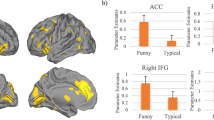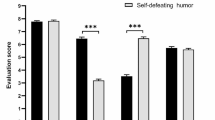Abstract
Humor is a lubricant of interpersonal relationships and is regarded as an important quality of individual creativity. Previous studies have mainly focused on passive humor appreciation and comprehension but ignored active humor generation, especially the cognitive process of humor generation. Based on the hypothesis that humor generation is similar to creative cognition, this study used humorous two-part allegorical sayings to explore whether humor generation involves the cognitive processes of the activation and inhibition of information. The experiment manipulated the duration (5/10 s) of the presentation of the first part of humorous two-part allegorical sayings, which are called “yinyu,” and the type of subthreshold probe words (humorous probe words/usual probe words). The results showed that the interaction between the duration of the presentation of yinyu and the type of subthreshold probe words was significant; the correct number of humorous probe words reported was significantly lower than that of usual probe words when the yinyu was presented for 5 s, which reflected the widespread activation of information. The correct number of humorous probe words reported was significantly higher than that of usual probe words when the yinyu was presented for 10 s, which suggested the inhibition of non-humorous information. This study revealed the dynamic cognitive processes of humor generation and verified possible cognitive similarities between humor generation and creative cognition.


Similar content being viewed by others
References
Adamczyk, P., Wyczesany, M., Domagalik, A., Daren, A., Cepuch, K., Błądziński, P., & Marek, T. (2017). Neural circuit of verbal humor comprehension in schizophrenia-an fMRI study. NeuroImage: Clinical, 15, 525–540.
Amabile, T. M., Goldfarb, P., & Brackfleld, S. C. (1990). Social influences on creativity: Evaluation, coaction, and surveillance. Creativity Research Journal, 3(1), 6–21.
Amir, O., & Biederman, I. (2016). The neural correlates of humor creativity. Frontiers in Human Neuroscience, 10, 597.
Amir, O., Biederman, I., Wang, Z., & Xu, X. (2015). Ha Ha! Versus Aha! A direct comparison of humor to nonhumorous insight for determining the neural correlates of mirth. Cerebral Cortex, 25(5), 1405–1413.
Beaty, R. E., Silvia, P. J., Nusbaum, E. C., Jauk, E., & Benedek, M. (2014). The roles of associative and executive processes in creative cognition. Memory & Cognition, 42(7), 1186–1197.
Benedek, M., Franz, F., Heene, M., & Neubauer, A. C. (2012). Differential effects of cognitive inhibition and intelligence on creativity. Personality and Individual Differences, 53(4), 480–485.
Bennett, M. P., Zeller, J. M., Rosenberg, L., & McCann, J. (2003). The effect of mirthful laughter on stress and natural killer cell activity. Alternative Therapies in Health and Medicine, 9(2), 38–45.
Bink, M. L., & Marsh, R. L. (2000). Cognitive regularities in creative activity. Review of General Psychology, 4(1), 59–78.
Bressler, E. R., & Balshine, S. (2006). The influence of humor on desirability. Evolution and Human Behavior, 27(1), 29–39.
Brodzinsky, D. M., & Rubien, J. (1976). Humor production as a function of sex of subject, creativity, and cartoon content. Journal of Consulting and Clinical Psychology, 44(4), 597.
Celso, B. G., Ebener, D. J., & Burkhead, E. J. (2003). Humor coping, health status, and life satisfaction among older adults residing in assisted living facilities. Aging & Mental Health, 7(6), 438–445.
Chan, Y. C., Chou, T. L., Chen, H. C., Yeh, Y. C., Lavallee, J. P., Liang, K. C., & Chang, K. E. (2013). Towards a neural circuit model of verbal humor processing: An fMRI study of the neural substrates of incongruity detection and resolution. NeuroImage, 66, 169–176.
Chang, J. H., Chen, H. C., Hsu, C. C., Chan, Y. C., & Chang, Y. L. (2015). Flexible humor styles and the creative mind: Using a typological approach to investigate the relationship between humor styles and creativity. Psychology of Aesthetics, Creativity, and the Arts, 9(3), 306.
Chang, Y. T., Ku, L. C., & Chen, H. C. (2018). Sex differences in humor processing: An event-related potential study. Brain and Cognition, 120, 34–42.
Christensen, A. P., Silvia, P. J., Nusbaum, E. C., & Beaty, R. E. (2018). Clever people: Intelligence and humor production ability. Psychology of Aesthetics, Creativity, and the Arts, 12(2), 136.
Clabby, J. F., Jr. (1980). The wit: A personality analysis. Journal of Personality Assessment, 44(3), 307–310.
Derks, P., & Hervas, D. (1988). Creativity in humor production: Quantity and quality in divergent thinking. Bulletin of the Psychonomic Society, 26(1), 37–39.
Dietrich, A., & Kanso, R. (2010). A review of EEG, ERP, and neuroimaging studies of creativity and insight. Psychological Bulletin, 136(5), 822.
Dixon, N. F. (1980). Humor-cognitive alternative to stress. Bulletin of the British Psychological Society, 33, 18–18.
Fredrickson, B., & Levenson, R. W. (1998). Positive emotions speed recovery from the cardiovascular sequelae of negative emotions. Cognition & Emotion, 12(2), 191–220.
Gavrilovic, J., Lecic-Tosevski, D., Dimic, S., Pejovic-Milovancevic, M., Knezevic, G., & Priebe, S. (2003). Coping strategies in civilians during air attacks. Social Psychiatry and Psychiatric Epidemiology, 38(3), 128–133.
Gernsbacher, M. A. (1991). Cognitive processes and mechanisms in language comprehension: The structure building framework. Psychology of Learning and Motivation, 27, 217–263.
Greengross, G., & Miller, G. (2011). Humor ability reveals intelligence, predicts mating success, and is higher in males. Intelligence, 39(4), 188–192.
Greengross, G., Silvia, P. J., & Nusbaum, E. C. (2020). Sex differences in humor production ability: A meta-analysis. Journal of Research in Personality, 84, 103886.
Houdé, O., & Borst, G. (2014). Measuring inhibitory control in children and adults: Brain imaging and mental chronometry. Frontiers in Psychology, 5, 616.
Houdé, O., & Borst, G. (2015). Evidence for an inhibitory-control theory of the reasoning brain. Frontiers in Human Neuroscience, 9, 148.
Hull, R., Tosun, S., & Vaid, J. (2017). What’s so funny? Modelling incongruity in humour production. Cognition and Emotion, 31(3), 484–499.
Kaufman, S. B., Kozbelt, A., Bromley, M. L., & Miller, G. F. (2008). The role of creativity and humor ability in human mating. In G. Geher, & G. F. Miller (Eds.), Mating Intelligence: Theoretical and Empirical Insight into Intimate Relationships (pp. 227–262). Mahwah, NJ: Erlbaum.
Kellner, R., & Benedek, M. (2017). The role of creative potential and intelligence for humor production. Psychology of Aesthetics, Creativity, and the Arts, 11(1), 52.
Koestler, A. (1964). The Act of Creation: A Study of Conscious and Unconscious Processes in Humor, Scientific Discovery and Art. New York: The Macmillan Company.
Kohn, N., Kellermann, T., Gur, R. C., Schneider, F., & Habel, U. (2011). Gender differences in the neural correlates of humor processing: Implications for different processing modes. Neuropsychologia, 49(5), 888–897.
Kohn, N. W., & Smith, S. M. (2011). Collaborative fixation: Effects of others’ ideas on brainstorming. Applied Cognitive Psychology, 25(3), 359–371.
Korovkin, S. Y., & Nikiforova, O. S. (2015). “Humor as a facilitator of insight problem solving,” Poster Presented at the EuroAsianPacific Joint Conference on Cognitive Science (Torino, IT).
Runco, M. A., & Pritzker, S. R. . (2020). Encyclopedia of creativity. In A. Kozbelt (Eds.), Humor (pp. 588-594). Academic press.
Kozbelt, A., & Nishioka, K. (2010). Humor comprehension, humor production, and insight: An exploratory study. Humor, 23(3), 375–401.
Lefcourt, H. M., Davidson-Katz, K., & Kueneman, K. (1990). Humor and immune-system functioning. Humor: International Journal of Humor Research, 3(3), 305–322.
Lu, J. G., Martin, A. E., Usova, A., & Galinsky, A. D. (2019). Creativity and humor across cultures: Where Aha meets Haha. Creativity and Humor. https://doi.org/10.1016/B978-0-12-813802-1.00009-0
McGee, E., & Shevlin, M. (2009). Effect of humor on interpersonal attraction and mate selection. The Journal of Psychology, 143(1), 67–77.
Mobbs, D., Greicius, M. D., Abdel-Azim, E., Menon, V., & Reiss, A. L. (2003). Humor modulates the mesolimbic reward centers. Neuron, 40(5), 1041–1048.
Moran, J. M., Rain, M., Page-Gould, E., & Mar, R. A. (2014). Do I amuse you? Asymmetric predictors for humor appreciation and humor production. Journal of Research in Personality, 49, 8–13.
Neely, M. N., Walter, E., Black, J. M., & Reiss, A. L. (2012). Neural correlates of humor detection and appreciation in children. Journal of Neuroscience, 32(5), 1784–1790.
Neuhoff, C. C., & Schaefer, C. (2002). Effects of laughing, smiling, and howling on mood. Psychological Reports, 91(3_Suppl), 1079–1080.
Nezlek, J. B., & Derks, P. (2001). Use of humor as a coping mechanism, psychological adjustment, and social interaction. Humor International Journal of Humor Research, 14, 395–413.
Nusbaum, E. C., Silvia, P. J., & Beaty, R. E. (2017). Ha ha? Assessing individual differences in humor production ability. Psychology of Aesthetics, Creativity, and the Arts, 11(2), 231.
O’Quin, K., & Derks, P. (1997). Humor and creativity: A review of the empirical literature. Creativity Research Handbook, 1, 223–252.
Perchtold-Stefan, C. M., Papousek, I., Rominger, C., Schertler, M., Weiss, E. M., & Fink, A. (2020). Humor comprehension and creative cognition: Shared and distinct neurocognitive mechanisms as indicated by EEG alpha activity. NeuroImage, 213, 116695.
Ruch, W., & Heintz, S. (2019). Humor production and creativity: Overview and recommendations. In S. R. Luria, J. Baer, & J. C. Kaufman (Eds.), Creativity and humor (pp. 1-42). London: Academic Press.
Shibata, M., Terasawa, Y., Osumi, T., Masui, K., Ito, Y., Sato, A., & Umeda, S. (2017). Time course and localization of brain activity in humor comprehension: An ERP/sLORETA study. Brain Research, 1657, 215–222.
Suls, J. M. (1972). A two-stage model for the appreciation of jokes and cartoons: An information-processing analysis. The Psychology of Humor: Theoretical Perspectives and Empirical Issues, 1, 81–100.
Sutu, A., Phetmisy, C. N., & Damian, R. I. (2021). Open to laugh: The role of openness to experience in humor production ability. Psychology of Aesthetics, Creativity, and the Arts, 15(3), 401.
Turner, R. G. (1980). Self-monitoring and humor production 1. Journal of Personality, 48(2), 163–167.
Valitutti, A., Toivonen, H., Doucet, A., & Toivanen, J. M. (2013). “Let everything turn well in your wife”: generation of adult humor using lexical constraints. In Proceedings of the 51st Annual Meeting of the Association for Computational Linguistics, 2, 243–248.
Zhao, Q. B., Li, S. Q., Chen, S., Zhou, Z. J., & Cheng, L. (2015). Dynamic neural processing mode of creative problem solving. Advances in Psychological Science, 23(3), 375–384.
Zhou, S., Chen, S., Wang, S., Zhao, Q., Zhou, Z., & Lu, C. (2018). Temporal and spatial patterns of neural activity associated with information selection in open-ended creativity. Neuroscience, 371, 268–276.
Zhu, X. C., Li, R. J., & Zhou, Z. J. (2009). The role of clues in chinese idiom riddle solving. Acta Psychologica Sinica, 41(05), 397–405.
Ziv, A. (1976). Facilitating effects of humor on creativity. Journal of Educational Psychology, 68(3), 318.
Funding
Scientific Research Fundation of Sichuan Normal University (22XW082).
Author information
Authors and Affiliations
Corresponding author
Ethics declarations
Conflict of interest
There are no competing interests with other people or organizations.
Ethical approval
All procedures performed in studies involving human participants were in accordance with the ethical standards of the Ethics Institutional Review Board of Central China Normal University.
Informed consent
Informed consent was obtained from all individual participants included in the study.
Additional information
Publisher's Note
Springer Nature remains neutral with regard to jurisdictional claims in published maps and institutional affiliations.
Rights and permissions
Springer Nature or its licensor (e.g. a society or other partner) holds exclusive rights to this article under a publishing agreement with the author(s) or other rightsholder(s); author self-archiving of the accepted manuscript version of this article is solely governed by the terms of such publishing agreement and applicable law.
About this article
Cite this article
Sun, C., Wang, M., Zhou, X. et al. Dynamic cognitive processes of humor generation: activation and inhibition of information. Psychological Research 87, 1607–1615 (2023). https://doi.org/10.1007/s00426-022-01752-1
Received:
Accepted:
Published:
Issue Date:
DOI: https://doi.org/10.1007/s00426-022-01752-1




